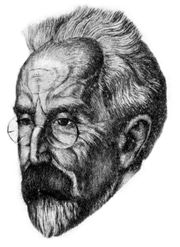
Emil Johann Lambert Heinricher
Encyclopedia

Austria
Austria , officially the Republic of Austria , is a landlocked country of roughly 8.4 million people in Central Europe. It is bordered by the Czech Republic and Germany to the north, Slovakia and Hungary to the east, Slovenia and Italy to the south, and Switzerland and Liechtenstein to the...
n botanist from Laibach (Ljubljana)
Ljubljana
Ljubljana is the capital of Slovenia and its largest city. It is the centre of the City Municipality of Ljubljana. It is located in the centre of the country in the Ljubljana Basin, and is a mid-sized city of some 270,000 inhabitants...
. In 1879 he received his doctorate at Graz
University of Graz
The University of Graz , a university located in Graz, Austria, is the second-largest and second-oldest university in Austria....
, and later was an assistant to Simon Schwendener
Simon Schwendener
Simon Schwendener was a Swiss botanist who was a native of Buchs in the Canton of St. Gallen.In 1856 he received his doctorate at the University of Zurich, where afterwards he was an assistant to Carl Wilhelm von Nägeli...
(1829–1919) in Berlin
Berlin
Berlin is the capital city of Germany and is one of the 16 states of Germany. With a population of 3.45 million people, Berlin is Germany's largest city. It is the second most populous city proper and the seventh most populous urban area in the European Union...
and Julius von Sachs
Julius von Sachs
Julius von Sachs was a German botanist from Breslau, Prussian Silesia.At an early age he showed a taste for natural history, becoming acquainted with the Breslau physiologist Jan Evangelista Purkyně. In 1851 he began studying at Charles University in Prague...
(1832–1897) in Würzburg
Würzburg
Würzburg is a city in the region of Franconia which lies in the northern tip of Bavaria, Germany. Located at the Main River, it is the capital of the Regierungsbezirk Lower Franconia. The regional dialect is Franconian....
. In 1888 he founded a botanical institute in Graz, and during the following year became a professor of botany at the University of Innsbruck. While at Innsbruck
Innsbruck
- Main sights :- Buildings :*Golden Roof*Kaiserliche Hofburg *Hofkirche with the cenotaph of Maximilian I, Holy Roman Emperor*Altes Landhaus...
he created a new botanical garden
Botanical garden
A botanical garden The terms botanic and botanical, and garden or gardens are used more-or-less interchangeably, although the word botanic is generally reserved for the earlier, more traditional gardens. is a well-tended area displaying a wide range of plants labelled with their botanical names...
in nearby Hötting. He also worked for a while at the Botanical Garden in Buitenzorg, Netherlands East Indies.
Heinricher is known for his research involving the morphology
Morphology (biology)
In biology, morphology is a branch of bioscience dealing with the study of the form and structure of organisms and their specific structural features....
, developmental history and physiology
Physiology
Physiology is the science of the function of living systems. This includes how organisms, organ systems, organs, cells, and bio-molecules carry out the chemical or physical functions that exist in a living system. The highest honor awarded in physiology is the Nobel Prize in Physiology or...
of parasitic angiosperms, as well as studies of parasitic plants such as mistletoe
Mistletoe
Mistletoe is the common name for obligate hemi-parasitic plants in several families in the order Santalales. The plants in question grow attached to and within the branches of a tree or shrub.-Mistletoe in the genus Viscum:...
and toothwort
Toothwort
Toothwort is a small genus of five to seven species of flowering plants, native to temperate Europe and Asia. They are parasitic plants on the roots of other plants, and are completely lacking chlorophyll. They are classified in the family Orobanchaceae. In addition, Cardamine concatenata is also...
. He also did extensive work in the study of botanical teratology
Teratology
Teratology is the study of abnormalities of physiological development. It is often thought of as the study of human birth defects, but it is much broader than that, taking in other non-birth developmental stages, including puberty; and other non-human life forms, including plants.- Etymology :The...
.
- The standard author abbreviation Heinr. is used to indicate this individual as the author when citing a botanical nameBotanical nameA botanical name is a formal scientific name conforming to the International Code of Botanical Nomenclature and, if it concerns a plant cultigen, the additional cultivar and/or Group epithets must conform to the International Code of Nomenclature for Cultivated Plants...
.

